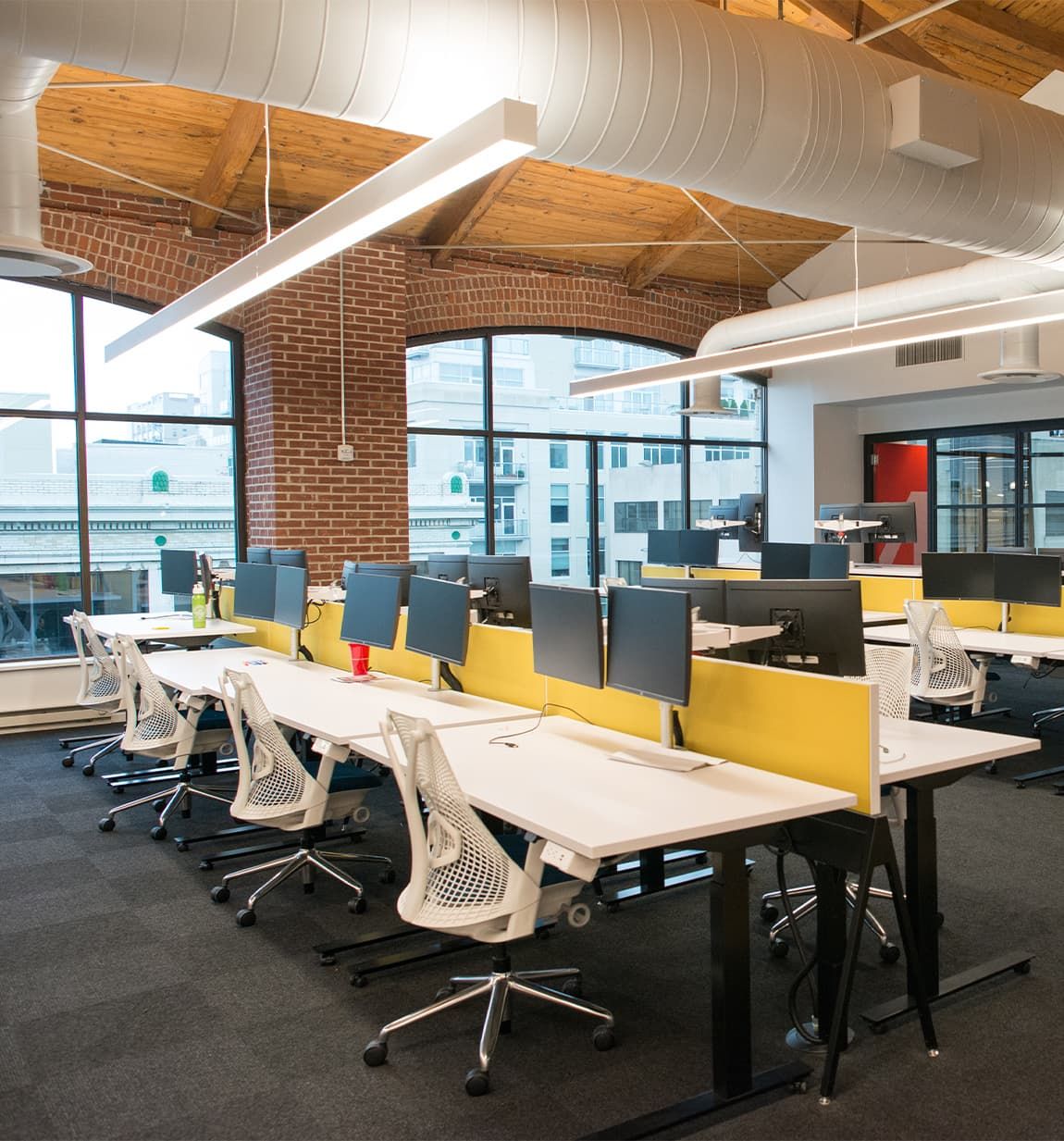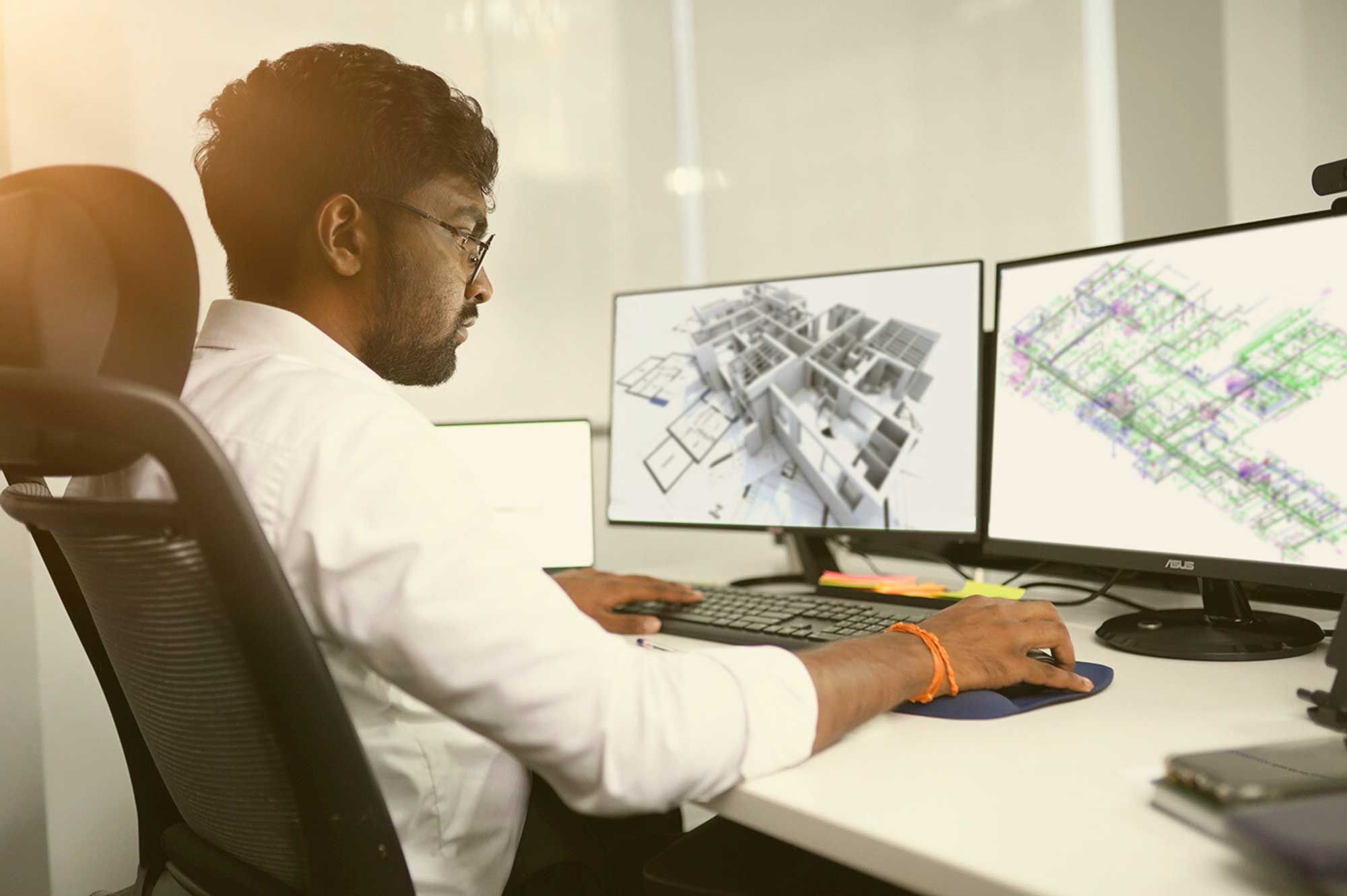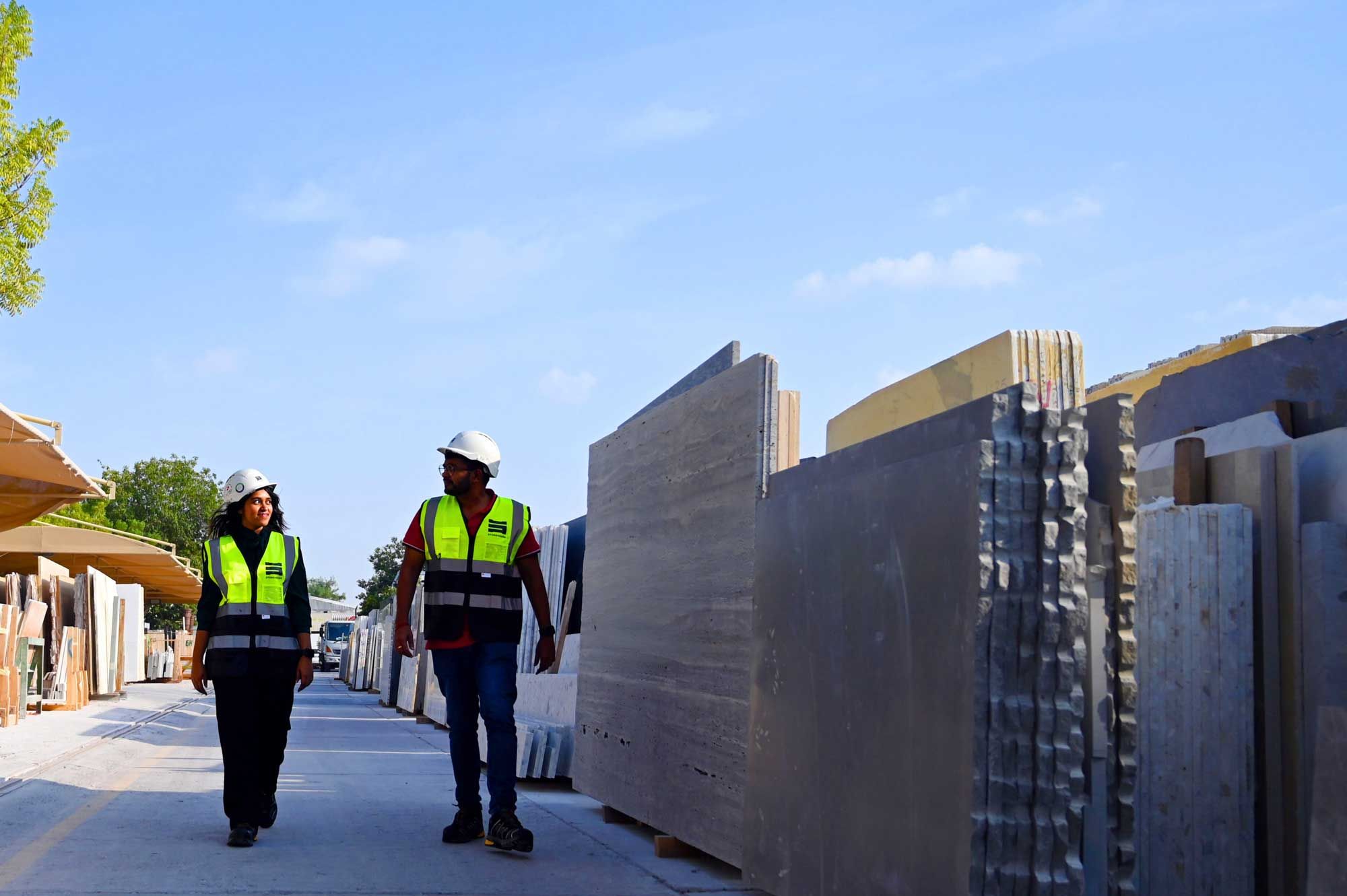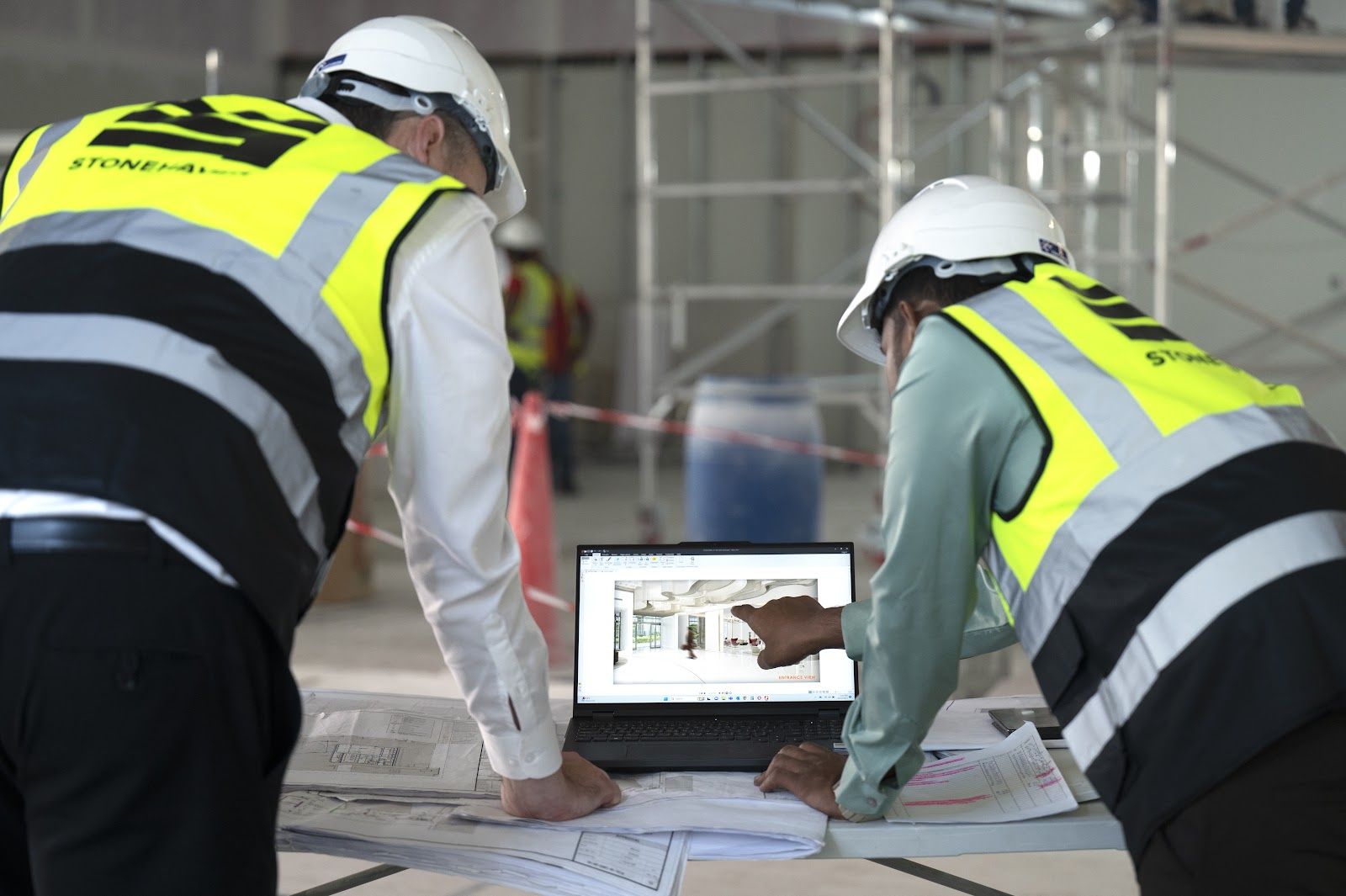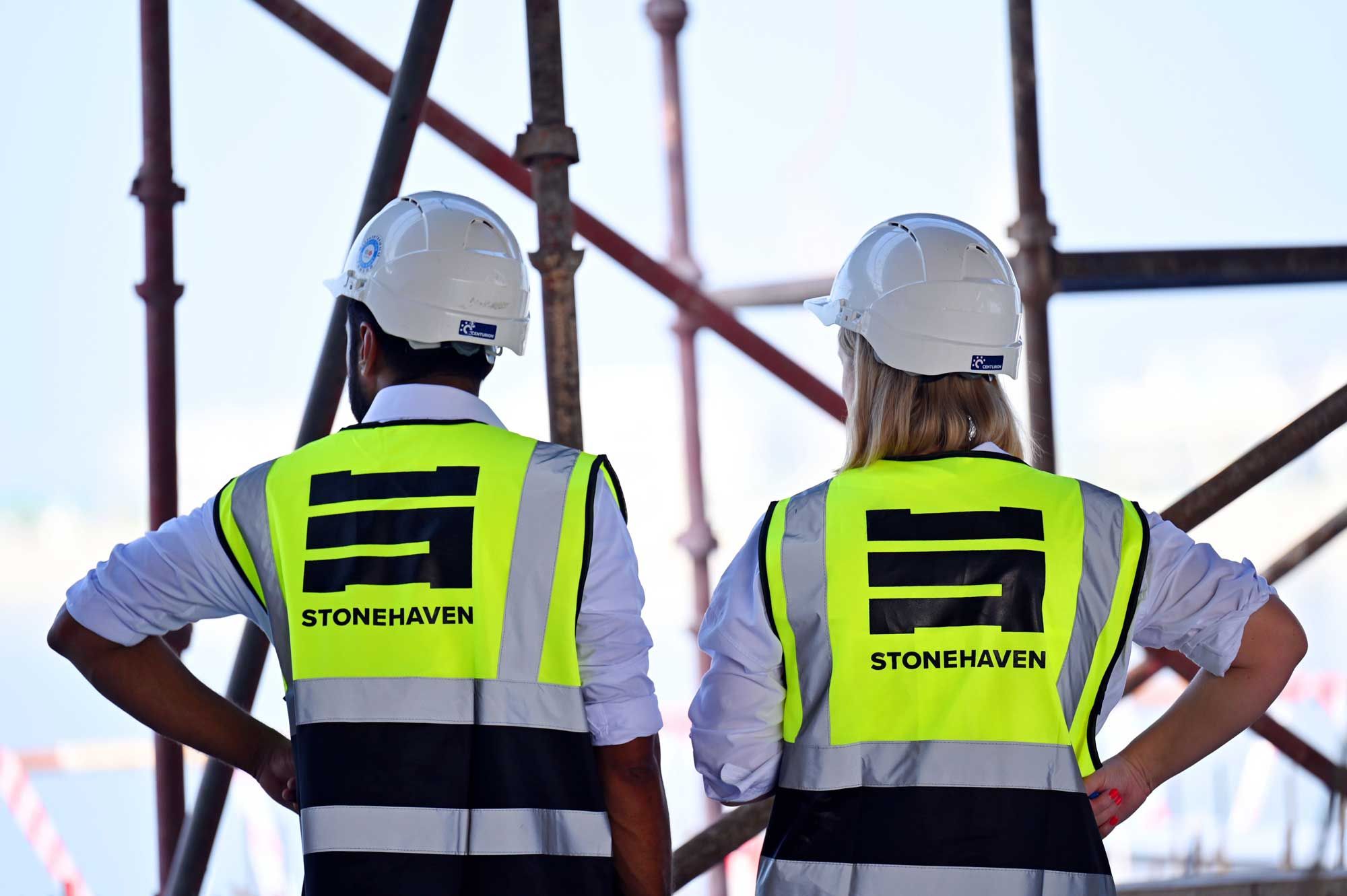The construction industry is entering an era of transformation. Traditional project management methodologies like Waterfall, long considered the backbone of project delivery, often fail to adapt to the dynamic challenges of today’s construction landscape. Enter Agile Project Management, a flexible, iterative methodology originally developed for software development. Now, it’s making its way into construction, reshaping how projects are conceptualised, executed, and delivered.
Agile’s core principles—flexibility, adaptability, and collaboration—align perfectly with the modern construction industry's need to navigate tight deadlines, complex requirements, and shifting client demands. By dividing projects into smaller, iterative phases and prioritising stakeholder collaboration, Agile enables construction teams to deliver higher-quality projects, faster.
This blog explores the transformative potential of Agile in the construction sector. We’ll dive into its key principles, benefits, challenges, and real-world applications. Whether you’re managing a high-rise build or a modular prefabrication project, this comprehensive guide will show how Agile can drive better results for construction professionals, contractors, and clients alike.
What is Agile Construction Management?
Agile Construction Management involves applying Agile principles to manage construction projects in a way that emphasises adaptability and client collaboration. Unlike traditional linear approaches like Waterfall Project Management, Agile promotes iterative workflows, where teams continuously deliver and refine work in response to feedback.
For construction, Agile introduces a paradigm shift. Imagine a scenario where a design flaw is discovered halfway through a building project. With traditional methods, this could derail the timeline and budget. Agile, on the other hand, thrives in such situations. By breaking the project into smaller, manageable phases, construction teams can respond to changes as they arise, incorporating feedback and maintaining progress.
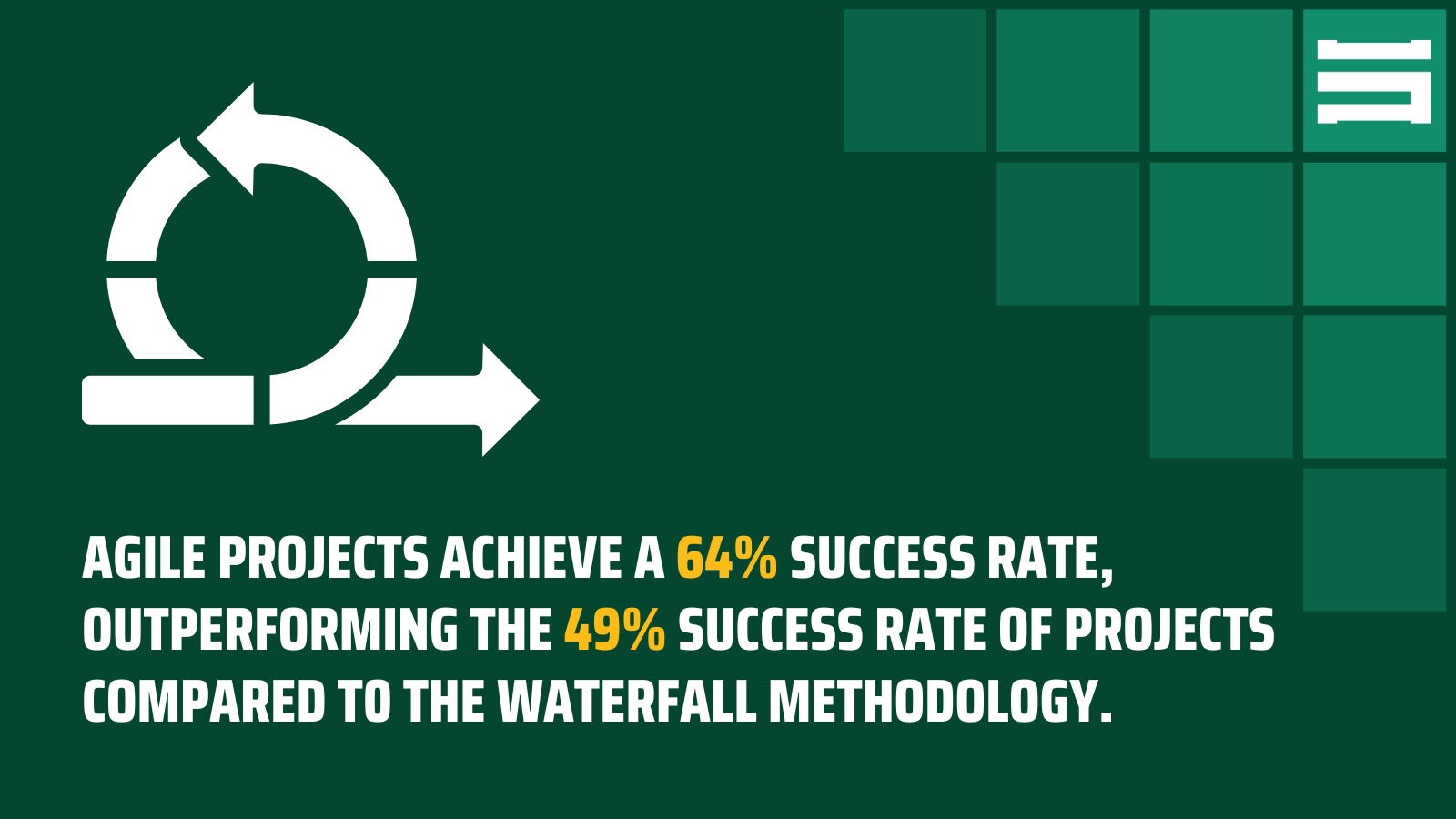
Why Agile is Needed in Construction
The construction industry has traditionally relied on rigid workflows that emphasise pre-defined plans and fixed timelines. Agile projects have a success rate of 64%, compared to 49% for projects under the traditional Waterfall methodology. While effective for simpler projects, this approach struggles to accommodate the increasing complexity of modern construction. Agile’s iterative nature allows for flexibility, enabling contractors, architects, and clients to collaborate closely and pivot as needed. For example, if sustainability becomes a higher priority mid-project, Agile makes it possible to adapt designs without derailing the entire process.
Real-World Applications of Agile in Construction
In modular construction, where building components are prefabricated off-site and assembled on location, Agile principles shine. Teams can iteratively test and refine modules, ensuring quality before full-scale production begins. Similarly, Agile is ideal for renovation projects, where unforeseen challenges like structural damage or client preferences often require real-time adjustments.
Agile Construction Management is no longer a theoretical concept; it’s a practical, results-driven approach transforming how projects are delivered.
What is an Example of Agile Project Management?
To understand how Agile principles are transforming the construction industry, let’s consider a practical example of how a residential building project could benefit from an Agile Project Management approach compared to the traditional Waterfall methodology.
The Traditional Approach
In a traditional construction project, teams typically follow a linear workflow, starting with extensive planning and design, followed by material procurement, then construction. All tasks are completed sequentially, and stakeholders often only see the results at the very end. This approach presents several challenges:
- Delays: If an issue arises during the construction phase, such as a design flaw or a material shortage, the timeline is often disrupted, causing significant delays.
- Limited Flexibility: Client feedback can’t be incorporated mid-project without significant cost and time overruns.
- Quality Risks: Issues may only be identified late in the process, requiring costly rework.
The Agile Approach
An Agile methodology breaks the construction project into smaller, manageable phases or iterations. By delivering functional segments incrementally, the team can address challenges, incorporate feedback, and continuously improve the project. Let’s break it down:
- Week 1-4: Foundations
The first iteration focuses on site preparation and laying the foundations. Stakeholders, including clients and structural engineers, review the progress to ensure everything aligns with expectations. Any necessary changes to the foundation design can be implemented before moving forward. - Week 5-8: First-Floor Framework
In the next sprint, the team builds the first-floor framework. During this phase, feedback from phase one is incorporated, and progress is reviewed. For example, if stakeholders suggest minor layout adjustments or modifications to structural reinforcements, these changes can be implemented without disrupting the project. - Week 9-12: Plumbing and Electrical Systems
The third iteration focuses on functional deliverables, such as installing plumbing and electrical systems on the completed floors. Teams collaborate with subcontractors and specialists to ensure everything meets safety and quality standards. Any issues, such as incompatible fixtures or electrical wiring concerns, are resolved during this sprint rather than at the end of the project.
Applying Agile in the Middle East: A Scenario
In the Middle East, where large-scale residential and mixed-use developments are common, Agile offers significant benefits. Take, for example, a luxury residential tower in Dubai:
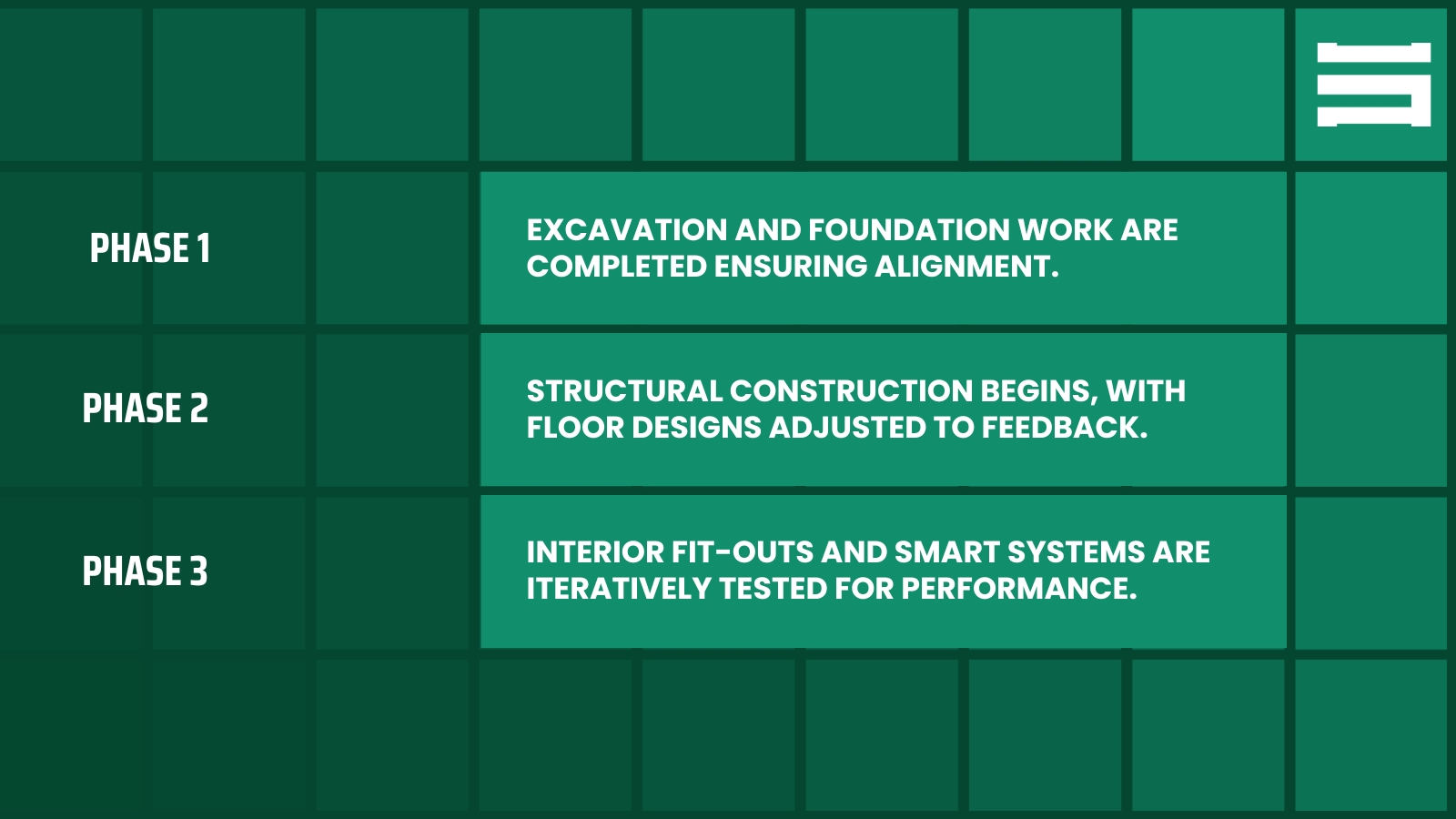
This Agile approach allows teams to adapt to the region’s unique requirements, such as incorporating sustainability certifications like Estidama or navigating local climate challenges. (Read more about Sustainable Construction Trends on our report here.) By ensuring continuous improvement and collaboration, Agile helps deliver projects faster, with higher quality, and greater client satisfaction.
What are the 5 Phases of Agile Project Management?
Agile Project Management is structured around five key phases, each essential for delivering a successful project. Let’s explore how these phases are applied to the construction industry:
1. Concept and Initiation
This phase sets the foundation for the project. Teams work collaboratively to define the project’s vision, goals, and scope. For example, in a commercial construction project, stakeholders might prioritise green building standards, modularity, or aesthetic appeal. Early alignment ensures that all parties are on the same page.
Unlike traditional methods, Agile begins with a high-level roadmap rather than rigid blueprints. Stakeholder input is prioritised to establish clear goals that remain adaptable as the project progresses. Tools like Building Information Modelling (BIM) are often used to visualise initial designs and gather feedback.
2. Iteration Planning
In this phase, the project is divided into iterations or sprints, each lasting a few weeks. Goals are set for each sprint. For example, the first sprint might focus on site preparation and foundation work, while subsequent sprints address framing, plumbing, and electrical systems.
The planning process is collaborative, involving architects, engineers, contractors, and clients. By breaking the project into smaller chunks, Agile reduces the risk of bottlenecks and ensures continuous progress.
3. Execution and Monitoring
Execution focuses on delivering the goals of each sprint. Teams employ visual tools like Kanban boards to track workflows and identify potential delays. Daily stand-up meetings keep everyone aligned and provide an opportunity to address challenges.
Tools like Microsoft Teams, Slack, and Procore are instrumental in this process, replacing traditional methods with advanced digital solutions. Procore, a robust construction management platform, consolidates workflows, tracks progress, and logs quality checks, helping project managers monitor and address potential delays or compliance issues in real time. This integration of technology ensures that execution is smooth, quality standards are upheld, and any issues are resolved promptly, keeping the project aligned with sprint objectives and timelines.
4. Testing and Quality Assurance
Deliverables from each sprint are inspected to ensure they meet both client expectations and regulatory requirements. For example, in a modular construction project, individual components might be tested for structural integrity before assembly.
This iterative testing reduces the likelihood of costly rework and ensures that quality remains a priority throughout the project.
5. Handover and Retrospective
At the end of each iteration, deliverables are handed over for use or evaluation. A retrospective meeting is held to reflect on what went well and identify areas for improvement. This feedback loop fosters continuous learning and improvement, making subsequent iterations more efficient and effective.
By embracing these five phases, construction projects can achieve higher levels of efficiency, quality, and client satisfaction.
What Projects Use Agile?
Agile Project Management is remarkably versatile, making it suitable for a wide range of construction projects, from small-scale renovations to large, complex infrastructure developments. The flexibility and iterative approach of Agile allow construction teams to adapt to changing requirements, streamline processes, and deliver high-quality results. Let’s explore how Agile can be applied across different types of construction projects:
1. Large-Scale Residential or Commercial Buildings
Agile is an excellent fit for large-scale residential or commercial construction projects, where coordination among various teams and stakeholders is critical. These projects often involve multiple phases, such as planning, design, foundation work, structural construction, and interior finishes. The agile methodology ensures that each phase progresses smoothly while allowing for adjustments based on real-time feedback.
For example:
- Residential Developments: A phased approach can be used to construct sections of a housing project, enabling homeowners to take possession of completed units while work continues onto others. This incremental delivery not only satisfies clients earlier but also generates cash flow for developers.
- Commercial Buildings: Agile is particularly useful for office complexes or shopping malls, where client needs might evolve. For instance, a tenant may request layout changes mid-project to accommodate new business requirements. The agile flexibility allows the team to incorporate such changes seamlessly.
2. Infrastructure Projects
Infrastructure projects, such as bridges, highways, or rail systems, often require agility due to external factors like weather conditions, regulatory changes, or community input. Traditional methodologies struggle to adapt to these dynamic elements, but Agile thrives in such environments.
For instance:
- Bridge Construction: Agile can break down the project into sprints, focusing on different components like foundations, superstructure, and safety installations. This ensures constant progress while addressing unforeseen challenges such as material shortages or geological surprises.
- Smart Cities: The integration of technology into infrastructure (e.g., smart traffic systems or sustainable energy grids) benefits significantly from Agile. Iterative testing of new technologies ensures that they function as intended before full-scale implementation.
3. Renovations and Refurbishments
Renovation projects are inherently unpredictable, making Agile an ideal choice. As work progresses, contractors often uncover hidden challenges, such as structural damage or outdated systems, requiring adjustments to the original plan. The Agile iterative nature enables teams to pivot quickly, ensuring the project stays on track.
For example:
- Heritage Building Restorations: Restoring a historic structure often involves dealing with unforeseen issues like decayed materials or compliance with preservation laws. Agile allows the team to address these issues in real time while keeping stakeholders informed.
- Office or Home Renovations: Client preferences may change mid-project, such as opting for a different design aesthetic or adding smart home technology. Agile’s collaborative approach ensures these changes are integrated efficiently.
4. Modular and Prefabricated Construction
Modular and prefabricated construction is inherently aligned with Agile principles. By building components off-site and assembling them on location, teams can work in sprints to complete and test individual modules before moving to the next phase. This method reduces waste, enhances quality control, and shortens project timelines.
For example:
- A prefabricated hospital wing can be constructed off-site while the main facility remains operational. Agile allows for iterative improvements to modules, ensuring they meet stringent health and safety requirements before delivery.
Benefits of Agile Project Management in Construction
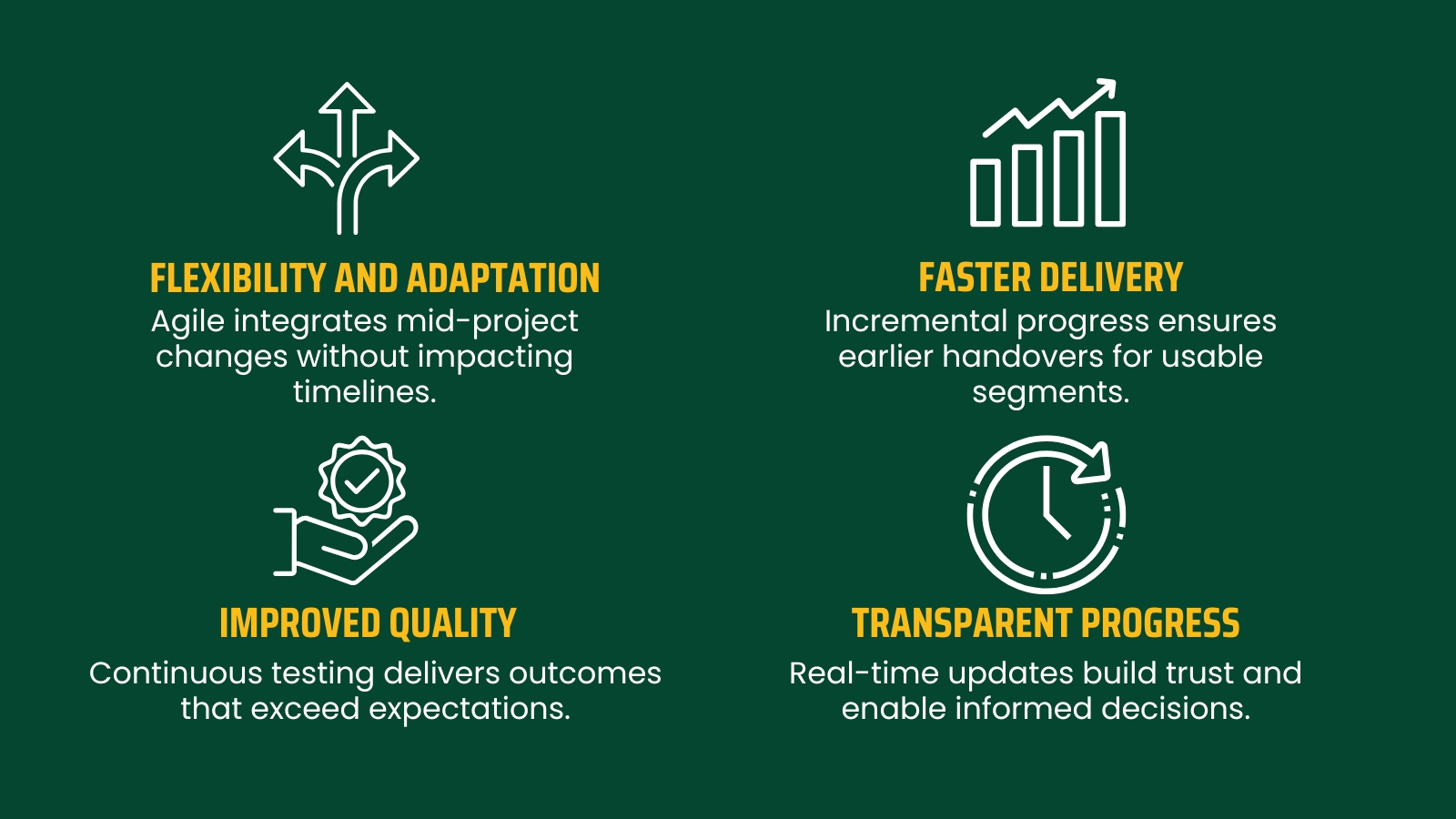
Adopting Agile methodologies in construction offers a wealth of benefits that extend far beyond traditional project management approaches:
1. Flexibility and Adaptability
Construction projects are often subject to unforeseen changes, from fluctuating material costs to evolving client preferences that need to be budgeted efficiently by cost managers of the project. Agile enables teams to adapt quickly without derailing timelines or budgets. For instance, if a client requests some design modifications mid-project, Agile allows these changes to be integrated seamlessly.
2. Faster Delivery of Usable Segments
Unlike traditional methods, where deliverables are only available at the project’s end, Agile allows for incremental delivery. For example, in a multi-story building, the ground floor can be completed and handed over while work continues onto the upper levels.
3. Improved Quality
Continuous testing and quality checks are integral to Agile. By identifying and addressing issues early, teams can deliver a final product that meets or exceeds expectations.
4. Greater Transparency
Agile promotes transparency by providing stakeholders with real-time updates on progress and challenges. This not only builds trust but also enables informed decision-making.
These benefits make Agile a game-changer for the construction industry, enabling projects to be delivered more efficiently and with greater client satisfaction.
Challenges of Agile in Construction
While Agile offers significant advantages, its adoption for construction managers comes with unique challenges:
- Cultural Resistance: Transitioning from traditional methods to Agile requires a mindset shift, which may be met with resistance from stakeholders accustomed to conventional workflows.
- Training Requirements: Teams need comprehensive training to understand Agile principles, roles, and tools, which can be time-consuming and resource intensive.
- Contractual Constraints: Traditional fixed-price contracts don’t align well with Agile’s flexible approach, necessitating new contract models.
- Integration with Existing Systems: Incorporating Agile into legacy workflows and systems can be complex and may require significant adjustments.
By addressing these challenges through training, stakeholder education, and flexible contracts, construction companies can unlock the full potential of Agile.
Conclusion
Agile Project Management is revolutionising the construction industry. By emphasising flexibility, collaboration, and iterative progress, Agile addresses the limitations of traditional methodologies and aligns with the demands of modern construction. While challenges exist, the benefits of Agile—enhanced quality, faster delivery, and greater client satisfaction—make it an essential tool for construction professionals.
About us
Stonehaven is a trusted project management company and construction consultant based in Dubai, offering comprehensive construction management services across the UAE with offices located in Dubai, UK and Sri Lanka. As one of the leading project management companies in Dubai, we manage projects from inception to completion, ensuring quality, efficiency, and cost-effectiveness at every stage.
We deliver value through expert project management consultancy services, tailored to meet the unique needs of each client. Our core services include Cost Management, Project Management, Construction Supervision, Engineering Support, Design Support, and Marketing & Communications. Whether you’re looking for construction consultants or project managers in the UAE and wider GCC region, Stonehaven is your trusted partner for achieving excellence in your next project.
At Stonehaven, we are redefining project management for the construction industry. As one of the top construction project management companies, we specialise in applying modern and evolving methodologies to deliver projects that exceed expectations. Whether you’re seeking a project management consultant or a full-service partner, our team ensures your projects are completed on time, within budget, and to the highest standards.
Contact us today to experience the future of construction project management.






